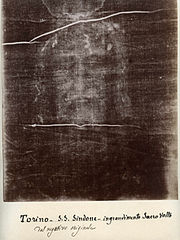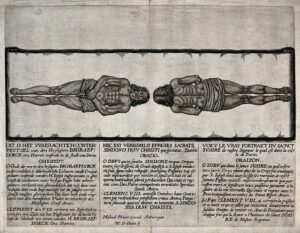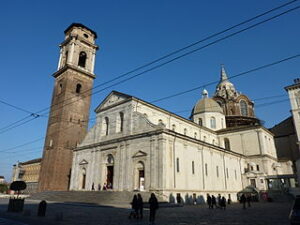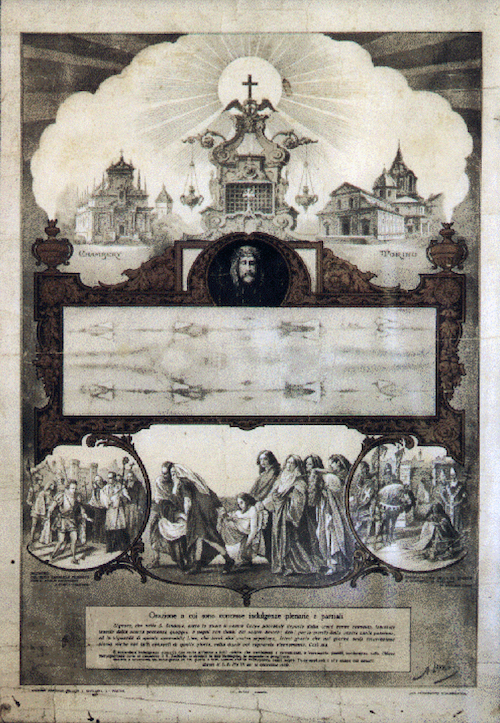
Dr. Gary Vikan and pal.
Author, art historian and former director of the Walters Museum, Dr. Gary Vikan, has a new book The Holy Shroud, A Brilliant Hoax in the Time of the Black Death. In it, Dr. Vikan sets forth the tangled story of the Shroud of Turin, the ostensible burial cloth of Jesus, a much-revered icon that the Catholic Church has never confirmed as authentic, since it has known for centuries that the 14th-century cloth is a hoax.
The Shroud of Turin is in fact a photograph-like body print of a medieval Frenchman created by a brilliant artist serving the royal court in the time of the Black Death. Nonetheless, thousands of believers and even some serious academics have dedicated themselves to affirming the shroud as a holy relic.
Dr. Vikan gave a presentation on October 8, 2020 at an American Bar Association program sponsored by its Art & Cultural Heritage Law Committee with host Peter K. Tompa and spoke with Cultural Property News afterward about how he came to write The Holy Shroud.
Let’s start with the history of the shroud and how it fits in with Christian relics.
The Shroud of Turin’s historical record begins shortly after the Great Plague hit Europe, about 1355. The plague swept through Europe between 1348 and 1350. COVID-19 is deadly but can you imagine an epidemic that has a mortality rate of between 30 and 90%? It took half the population of Paris in just nine months.

Photographer Secondo Pia’s 1898 negative of the image on the Shroud of Turin has an appearance suggesting a positive image. It is used as part of the devotion to the Holy Face of Jesus. Image from Musée de l’Élysée, Lausanne.
You may wonder what, if anything, the shroud has to do with litigation and the law. Unlike other famous Christian relics, the shroud entered the world under an enormous legal cloud. It appeared in a tiny wooden church in northern France. The prelates of the church were broadcasting far and wide that it was the true burial cloth of Jesus, bearing his imprint. The bishop of the diocese knew that it wasn’t and in fact he knew the person who had created it. He was really upset and he took the issue to the Pope, who was in Avignon at that time, and they went back and forth for almost forty years in what was essentially ecclesiastical litigation, until finally, in January of 1390, the Pope said ‘yes you can show it to people but you must be absolutely clear this is a copy of what may have been the burial shroud of Jesus.’ Because, there was absolutely nothing historically to connect this little town in France to first century Golgotha.
There is a category of relics in Christianity that is quite special. These are relics that are also images – for example there is Mexico City’s Our Lady of Guadalupe’s tilma, a cloak on which the image of the Virgin Mary appears. You may also have heard of the Veil of St. Veronica. As the story goes, Jesus stumbled on the road to Calgary and because he was bleeding and sweating profusely she pressed a cloth to his face and his image was retained on the cloth. That’s what a relic in Christianity is – either a body or part of a body or something that has touched the body of Christ or of a holy person. But it’s also an icon by virtue of bearing an image. This type of relic appears in Christianity for the first time around 600 years after Christ and that’s the category to which the Turin shroud belongs.
Do you have an opinion about what makes the shroud so convincing to so many? There was a warning that was supposed to be read to pilgrims going to see it but the warning was clearly forgotten over time. Why does it continue to be reverenced?

Annemarie Schwarzenbach, photographer, Knoxville Tennessee Two boys looking at shop windows in which pictures of the Dillinger brothers are exhibited. 1936-1938. Wikimedia Commons.
It took me a long time to figure out that puzzle. The reason the shroud has not gone away is because the image is charismatic. By that I mean it is a mysterious and powerful figure. If you have seen it you know that it is of very fine linen, about 14 feet long and 3 feet wide. It bears the image, front and back – like a hot dog bun impression – of a body of a man. When viewing it, you see an image of cruel punishment. It bears the marks of lacerations and whips, and you can see a bloody wound in Christ’s right chest. Blood seems to be trickling from his forehead.
This image of suffering has a mysterious power. I remember when I was a small child, after John Dillinger’s death car – the car in which he was killed by the cops – came to my little town in northern Minnesota and for 10 cents we could come and look at this car. It had a bullet hole in one window and bloodstains on the seats. What really got my attention – I can still see it in my mind’s eye – was a photograph of Dillinger in the morgue where he looks both dead and alive, with a bullet hole here and a bullet hole there. What I am trying to say is that images of dead people are really disturbing and they impact us very powerfully.
How does the way the shroud was made give that impact?
The shroud was actually made by touching a body, by overlaying a textile on a human being. The human being with lathered up with an ingredient for making a medieval ink. The fabric was coated with another ingredient for the ink. The two ingredients themselves are pretty translucent, but when they are pressed together the mixture turns a deep purple black. Over time the color fades and rusts into ferrous oxide – it turns to a pale sepia color. So in fact the shroud was made by contact with the body of a human being. Once the print of the body was made, an artist came along and added the little marks of wounds – the seeming wound in the side and the blood dripping from the forehead.
Altogether, the result is something close to Andy Warhol’s lithographs of car crashes. If you have ever seen them, you can’t forget them. They are images of mashed up Chevys and Fords from 1948 and 1952 with bodies dangling out of them.

Full-length image of the Turin Shroud before 2002.Wikimedia Commons.
The shroud is a dreamlike image of a battered dead man. Those people who believe in the shroud and study it and talk about it for their entire lifetimes often say, ‘you know I saw this as a teenager, I saw this as a 10 year old, I saw this for the first time when I was 22, and it changed me.’ Once they come to that conclusion, they cannot be dissuaded from it. It stays with them. No amount of common sense or science or history or art history or religious history, all of which are woven into my book, will change that. Carbon 14 tests which date the shroud to the 14th century will not dissuade them from that core conviction. They have seen Jesus.
The facial type on the shroud does not conform to what Palestinians of the first century looked like – nor is there any information on what the face of Jesus looked like. It actually matches the fourteenth century perception of what Jesus looked like. By the way, it matches the images that I was brought up with in my little church. Long hair and drooping mustaches on a long narrow face. When people saw that image in the Middle Ages they said, ‘I know who that is, that’s Jesus when he was dead. That must be the textile in which he was wrapped.’
Didn’t the shroud actually have a revitalization of interest with the coming of photography?
If you want to put the shroud in its proper context in art history – you can put it in with photography. It’s a contact print. In the 19th century as in the 16th century, the shroud was a relic among tens of thousands of relics. A number of the relics bore images and some were believed to have been burial cloths. Then in 1898, an amateur Italian photographer took a photograph of the shroud. When you see it in real life its pale sepia tones are very hard to see – it kind of shimmers. But when the photographer looked at the negative, he nearly dropped it in shock. (The negative was glass, it still exists.) All of a sudden the image is very clear and detailed. All the details could be easily seen. He and many others became convinced that this was a photograph of Jesus, 2000 years before the invention of photography.
What keeps the story of the shroud going is not miracles, because the shroud does not do very many miracles. It’s the image itself that people think is miraculous. There aren’t any big miracles associated with the shroud as there are for Our Lady of Guadalupe. One of the most recent miraculous images of her appeared in the bark of a tree on a street in a town in suburban New York City. People go to venerate it and they touch the bark.

The Holy Shroud of Turin. Engraving. Wellcome Trust,. Wikimedia Commons, Creative Commons Attribution 4.0 International license.
But because the image in the shroud was itself miraculous, a ‘photograph’ created by Jesus himself, it developed a huge following among believers. There is now a discipline called Sindonology, from the Greek word sindon, used for the burial cloth mentioned in the Gospel of St. Mark. The people who study the shroud have a website, shroud.com, and they have published vast numbers of books. They have come up with what they think is evidence of details that prove the shroud is real, for example, that leptons, little coins, are said to be shown on Jesus’ eyes in the shroud. They take enlargement photographs and then overlay images of leptons and find points of coincidence.
The image is so faint that it’s like looking up in the clouds and seeing a face or looking you know into murky water; it’s a sort of Rorschach test. If you think you are looking at Jesus, that Rorschach test invites you to see things that aren’t there. For example, one of the most recent crazy things is that an archivist, ten or fifteen years ago, came up with the idea that the obituary of Jesus in Aramaic, Hebrew, and Greek is written in a strip across the chest of the figure. By the way, those who know what burial practices in first century Palestine were, know there is no evidence they put coins over the eyes of the dead.
That was a Greek thing.

The case of the Shroud of Turin inside the Cattedrale Metropolitana di San Giovanni Battista, Torino (Turin) Italy.
So it goes on and on. This aspect of shroud mania started in 1973 when people had access to it with something essentially like Scotch tape and they placed Scotch tape on it and sent it to a Swiss fellow named Max Frei [a Swiss police criminologist] who claimed to be a specialist in pollen. Max Frei examined what was on the tape and stated that this looks like pollen and that pollen appears in the Holy Land, and it’s a springtime pollen. So people got crazy about that. Now he didn’t also say that the same pollen also appears in France in the springtime and he ignored the fact that the shroud has been touched by tens of thousands of people over the years with their handkerchiefs and who knows what. There was one guy at Duke University who found 27 different kinds of flowers printed in the faint detail on the linen. He said the flowers only grow in Judea and they blossom in spring. There are conferences held each year, often in southern states at religious universities, with sessions devoted to each of these subjects; the pollen, the flowers, the coins, and the words that may or may not be found on the shroud. You’ll find a good example of that thinking if you just Google “Satan and the twin towers.” You will see an image of smoke coming out of twin towers before they collapsed on 9/11 and what appears to be in the smoke the face of Satan. If that is Satan, then there are leptons on the eyes of Jesus from the shroud of Turin.
So, reading your book, it is evident that Christian relics definitely have a real power for many people even today. Are there any parallels in other cultures you can consider?
In the 1980s, I was in my 30’s. I don’t know why, but I became fixated on two things which seemed unrelated at the time. One was the Shroud of Turin and the other one was Elvis Presley. Not Elvis Presley per se but Graceland. I was so fascinated by the Elvis fans and what went on there, especially in August during what they called Death Week, the seven days around the anniversary of his supposed martyrdom. In fact, he died of a drug overdose on a toilet in his house and went into rigor mortis before he was found.

Grave of Elvis Presley at Graceland. Author Hal333, 22 June 2020, Wikimedia Commons, Creative Commons Attribution-Share Alike 4.0 International license.
In any event, there are miracles associated with Elvis. People collect Elvis stuff. I have a piece of Elvis’ shirt, I have a piece of Melody Gate, I have a scarf that Elvis gave to a fan in Las Vegas that has certainly, if one were to do it scientifically, Elvis DNA in sweat on it, and so on.
You know, saints have “vitae” and these are kind of made up stories anchored in truth. They conform to a certain profile; a miraculous birth, heroic deeds in life and martyrdom. The Elvis story is told exactly that way. He was born on the 8th of January, 1935 in Tupelo, Mississippi. At four in the morning when he was born there was a blue ring surrounding the moon, a sign that something special had happened. And he did great deeds during his life, not just by performing, but essentially by channeling Jesus.
His martyrdom is explained this way if you are an Elvis fan: even if you accept that he did not die from a heart attack but rather from a drug overdose, the only reason he took drugs was because he was struggling so hard to serve us. Struggling so hard to make us happy.
He would take stimulants, amphetamines, before a concert but he would then get so keyed up he could not sleep for days in a row, so he would have to take soporific drugs to sleep. Never street drugs like heroin but he took every kind of Quaaludes or whatnot. He had eleven Quaaludes in his system when he died. In that way, true fan will say Elvis died for us. I don’t want to offend anyone, but much as our current President would say, I got Covid for you.
Can you visit and see the shroud?
No, you can’t actually. It’s shown only on rare occasions. The next showing is in 2025. The last showing was in 2015. When it’s not being shown it is in a reliquary in a beautiful chapel attached to the east end of the Cathedral of Saint John in Turin, Italy. The reason that it ended up in Turin is it belonged to the House of Savoy until 1983. Now the Vatican owns it but until 1983 it was a privately owned relic, which is odd in itself. The House of Savoy was centered in Turin so that’s why it ended up there.
I guess we know where you are going in 2025?

Cattedrale Metropolitana di San Giovanni Battista, Torino (Turin) Italy. Wikimedia Commons.
[Laughs] Well if Pope Francis reads my book, maybe they won’t show it. The Catholic Church knows it is not the burial shroud of Jesus. They’ve known it since 1390, so when you hear Francis or Benedict talk about the shroud, they will use the word “icon” very purposefully. They scrupulously avoid the word relic because they know it’s not a relic. They know it has never touched the body of Jesus. They fully accept the Papal Bull of January 1390. This is kind of benign neglect of the truth that’s familiar in the Catholic Church. You can say, well, no harm done; it’s a vehicle for piety and all of that’s true. Any icon is a vehicle for piety, sacred images are vehicles for piety. But when people believe in something that is not true, there’s some deception there. What bothered people in the 14th century bothers me and others today.
There is a difference between veneration and idolatry. The argument against the shroud 600 years ago was that if you don’t acknowledge what it really is, namely a human made image, you invite people to commit idolatry and that’s what’s going on right now.
About 30 years ago there was a professor, Garman Harbottle, from Brookhaven National Laboratory who did carbon 14 tests on the shroud. Does that ring a bell?

Negative and positive images of the Shroud of Turin.
It was 1988 and the actual tests were done in three different sites at Tucson, Arizona, Zurich, Switzerland and Oxford in England and they were all blind tests and the overseeing organization was the British Museum. They took a very small piece of cloth from the right-hand corner of the shroud. The tests came back in October of 1988 and were announced at the British Museum by the three universities. The results were that it dated between the years of 1260 at 1390 and if you split the difference that comes out as 1325 CE. By the way, that’s the dating of when the flax was harvested from which the linen was woven. It is also just 30 years from the date that the shroud first appears in the historical record. However, if you go to shroud.com where it talks about the carbon dating, there is an argument that it was undertaken by people who wanted to discredit Christianity. According to this story, the scientists took a piece of linen that came from another textile and swapped it out with a piece that was cut off the shroud secretly and surreptitiously.
Gary Vikan’s other books include Sacred and Stolen: Confessions of a Museum Director, Select Books (2016), From the Holy Land to Graceland, American Alliance of Museums (2012), and Early Byzantine Pilgrimage Art, Dumbarton Oaks Byzantine Collection Publications (1982).
 Poster advertising the 1898 exhibition of the Shroud of Turin. The poster was approved by Pope Pio IX. Wikimedia Commons, public domain.
Poster advertising the 1898 exhibition of the Shroud of Turin. The poster was approved by Pope Pio IX. Wikimedia Commons, public domain. 

